Spur-winged Goose
- February 21, 2024
- 0 comment
The Spur-winged Goose, scientifically known as Plectropterus gambensis, is a captivating waterfowl species native to the diverse landscapes of sub-Saharan Africa. Renowned for its striking appearance and unique behaviors, this goose species holds a significant ecological role within its habitat. With its distinct combination of black, white, and brown plumage, the Spur-winged Goose stands out among its avian counterparts. Notably, it bears a sharp spur-like projection on its wing, lending it its distinctive name.

These geese are commonly found inhabiting various wetland environments such as marshes, swamps, and lakeshores across the African continent. Social creatures by nature, Spur-winged Geese often congregate in flocks, particularly during the breeding season. They exhibit monogamous breeding behavior and meticulously construct nests near water bodies, where both parents take turns incubating the eggs and caring for the young goslings.
While not classified as endangered, Spur-winged Geese face threats from habitat loss, pollution, and hunting in certain regions, underscoring the importance of conservation efforts to ensure their continued presence in the wild. Overall, the Spur-winged Goose serves as a captivating symbol of Africa’s rich avian biodiversity and warrants attention for its conservation and protection.
| Specification | Description |
|---|---|
| Scientific Name | Plectropterus gambensis |
| Common Name | Spur-winged Goose |
| Habitat | Wetlands, marshes, swamps, lakeshores |
| Distribution | Sub-Saharan Africa |
| Plumage | Combination of black, white, and brown |
| Wing Spur | Sharp spur-like projection on wing |
| Social Behavior | Often found in flocks, especially during breeding season |
| Breeding | Monogamous breeding pairs; nests near water bodies |
| Diet | Aquatic vegetation, grasses, small invertebrates |
| Conservation Status | Not endangered, but faces threats from habitat loss, pollution, and hunting |
| Importance | Plays crucial role in wetland ecosystems, including seed dispersal and controlling vegetation growth |
| Size | Large waterfowl species in Africa |
| Migration | Undertakes seasonal migrations for feeding and nesting |
| Predators | Vulnerable to predation by various mammals and birds |
| Lifespan | Typically lives for several years in the wild |
The Spur-winged Goose (Plectropterus gambensis) is a fascinating waterfowl species native to sub-Saharan Africa. Known for its striking appearance and unique behaviors, this goose species holds significant ecological importance in its habitat.
Physical Characteristics
Plumage
The plumage of the Spur-winged Goose is characterized by a striking combination of colors. These geese typically have predominantly white feathers on their bodies, with contrasting black plumage on their wings and tail. Additionally, they often display patches of brown feathers, particularly on their backs and necks. This unique coloration serves as effective camouflage in their wetland habitats, helping them blend into their surroundings and evade predators. During flight, the contrasting black and white colors of their wings create a visually striking appearance against the sky.
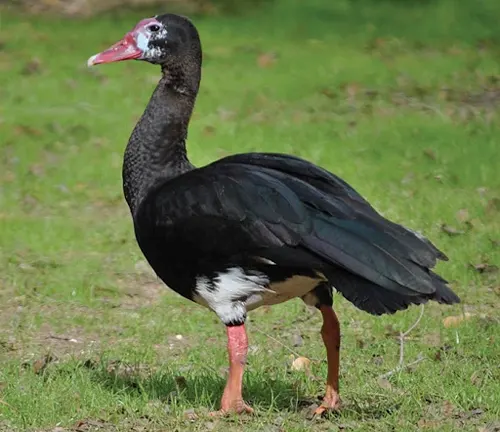
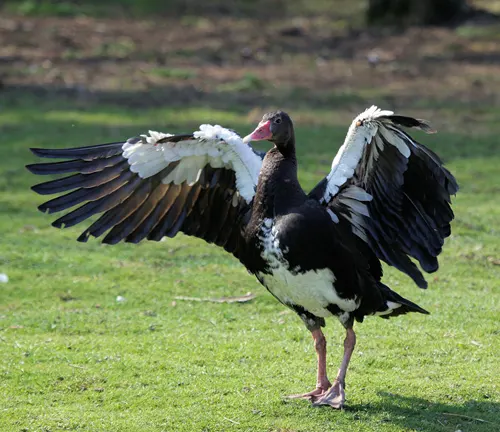
Spur on Wing
One of the most distinctive features of the Spur-winged Goose is the presence of a sharp spur-like projection on its wing. This spur, located on the leading edge of the wing near the shoulder, is a bony structure covered by feathers. It is more prominent in males than females and serves various purposes. While the exact function of the spur is not fully understood, it is believed to play a role in territorial disputes and defense against predators. During aggressive encounters with rivals or threats, Spur-winged Geese may use their spurs as weapons, inflicting injuries on opponents. Additionally, the presence of the spur may serve as a visual signal of dominance or maturity among individuals within the flock. Overall, the spur on the wing is a unique adaptation that sets the Spur-winged Goose apart from other waterfowl species and contributes to its fascinating biology.
Habitat and Distribution
Habitat
Spur-winged Geese inhabit a variety of wetland habitats across their range in sub-Saharan Africa. These habitats include marshes, swamps, lakeshores, riversides, and floodplains. They are typically found in areas with abundant aquatic vegetation and access to shallow water for feeding and nesting. Spur-winged Geese are well adapted to wetland environments and are often observed foraging in shallow water or grazing on adjacent grasslands. Their habitat preference for wetlands makes them important indicators of ecosystem health, as they rely on these habitats for food, shelter, and breeding sites.
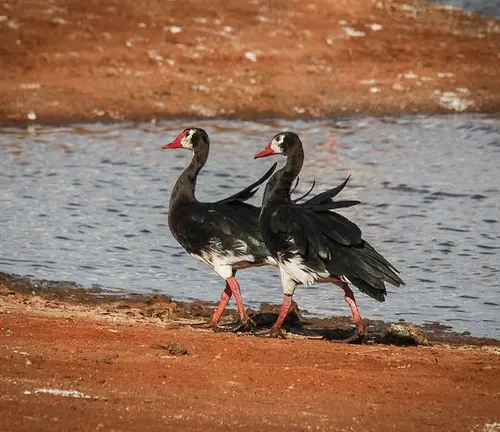
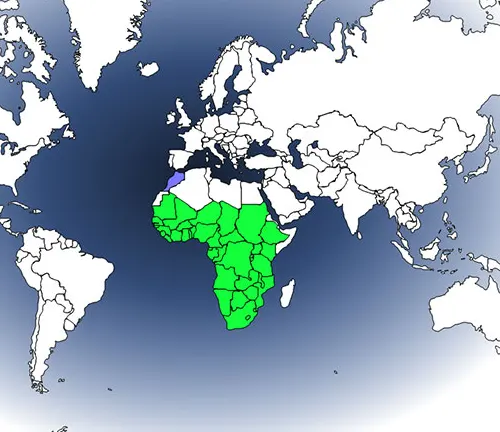
Distribution
The Spur-winged Goose has a widespread distribution throughout sub-Saharan Africa, ranging from Senegal and Mauritania in West Africa to Ethiopia and Somalia in the East, and southward to South Africa. They are absent from the dense rainforests of Central Africa but can be found in a variety of other habitats across the continent. Within their range, Spur-winged Geese are most commonly encountered in regions with extensive wetlands, such as the Okavango Delta in Botswana, the Niger Delta in Nigeria, and the Zambezi River basin in Zambia and Zimbabwe. While they are primarily sedentary birds, some populations may undertake seasonal migrations in response to changes in food availability or breeding conditions. Overall, the Spur-winged Goose exhibits a broad distribution across Africa’s wetland ecosystems, where it plays a vital role in maintaining the ecological balance of these habitats.
Behavior and Social Structure
Spur-winged Geese exhibit fascinating behaviors and possess a structured social organization within their flocks. Here are some insights into their behavior and social structure:
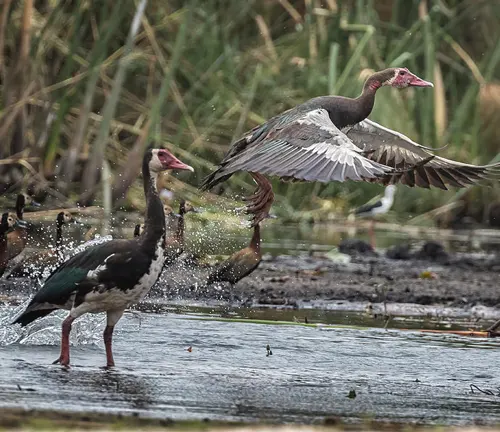
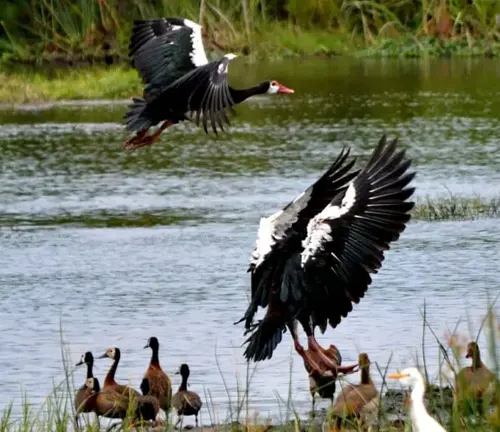
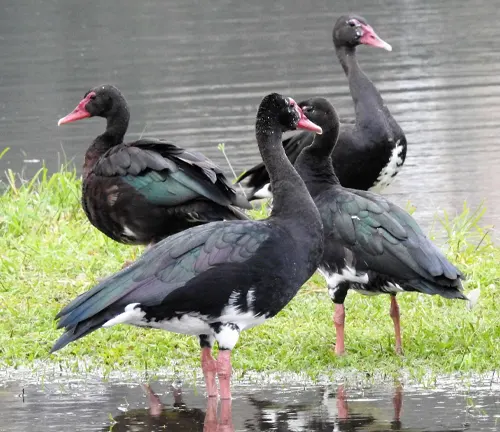
- Social Behavior: Spur-winged Geese are highly social birds, often forming large flocks, particularly during the non-breeding season. These flocks can consist of dozens to hundreds of individuals, which provide benefits such as increased vigilance against predators and improved foraging efficiency.
- Territoriality: During the breeding season, Spur-winged Geese become territorial, with breeding pairs defending nesting sites and surrounding areas from intruders. They may engage in aggressive displays and vocalizations to deter potential rivals from encroaching on their territory.
- Communication: Communication among Spur-winged Geese occurs through a variety of vocalizations, including honking calls, squawks, and hisses. These vocalizations serve to maintain contact within the flock, signal alarm in response to threats, and establish dominance or territorial boundaries.
- Breeding Behavior: Spur-winged Geese form monogamous breeding pairs, with individuals typically mating for life. Breeding pairs engage in elaborate courtship displays, which may include synchronized swimming, head bobbing, and vocalizations. Once a pair bond is established, they select a suitable nesting site near water and construct a nest from grasses and vegetation.
- Parental Care: Both male and female Spur-winged Geese participate in incubating the eggs and caring for the young goslings. They take turns tending to the nest and protecting the offspring from predators. Spur-winged Geese are attentive parents, guiding their young in foraging and teaching them essential survival skills.
- Aggression and Defense: While generally not aggressive, Spur-winged Geese can become defensive when their nests or offspring are threatened. They may engage in confrontations with predators or rival geese to protect their territory and ensure the safety of their offspring.
- Flocking Behavior: Flocks of Spur-winged Geese often exhibit coordinated movement patterns, with individuals flying in V-shaped formations during migration or foraging in synchronized groups on the water’s surface. This flocking behavior enhances their efficiency in locating food resources and provides protection against predators.
Feeding Habits
Spur-winged Geese are herbivorous birds with specialized feeding habits adapted to their wetland habitat. Here’s an overview of their feeding behavior:
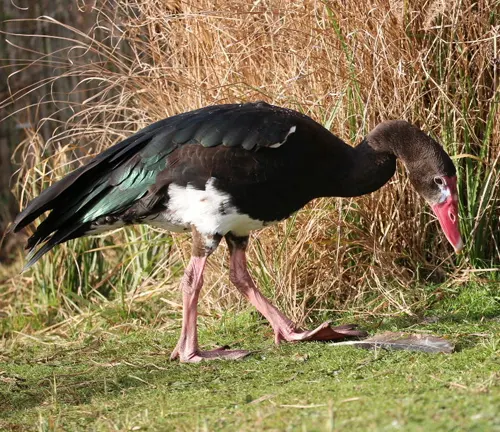
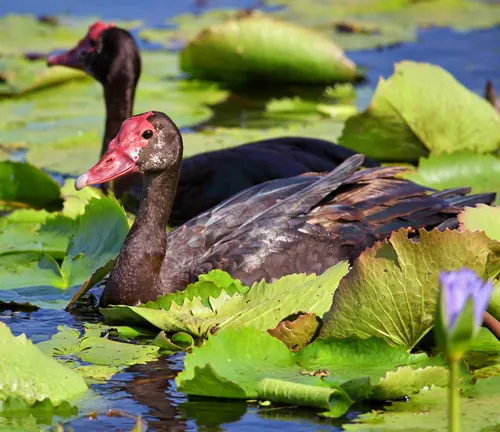
- Diet: Spur-winged Geese primarily feed on a variety of plant matter, including aquatic vegetation, grasses, sedges, and herbs. They are known to graze on grasslands adjacent to wetlands and wade into shallow water to access submerged vegetation.
- Aquatic Foraging: Spur-winged Geese are well adapted to foraging in water, where they use their long necks and bills to reach underwater vegetation. They may submerge their heads and necks while swimming, upending to reach plants growing below the surface.
- Grassland Grazing: In addition to aquatic plants, Spur-winged Geese also feed on grasses and other vegetation found in terrestrial habitats surrounding wetlands. They are often seen grazing on grasslands, meadows, and agricultural fields, particularly during the non-breeding season when water levels may be lower.
- Selective Feeding: Spur-winged Geese are selective feeders, preferring certain types of plants over others based on availability and nutritional value. They may target specific plant species or parts of plants, such as tender shoots, leaves, and seeds, depending on their dietary preferences and seasonal food availability.
- Feeding Behavior: Spur-winged Geese exhibit both diurnal and nocturnal feeding patterns, depending on factors such as temperature, food availability, and predation risk. They may forage individually, in pairs, or in large flocks, utilizing their keen sense of sight and hearing to locate food resources.
- Seed Dispersal: As herbivores, Spur-winged Geese play an important role in the dispersal of seeds of various wetland plants. After consuming fruits and seeds, they excrete undigested seeds in their feces, which can germinate and grow in new locations, contributing to plant diversity and ecosystem health.
Reproduction and Nesting
Spur-winged Geese engage in intricate reproductive behaviors and nesting strategies to ensure the successful hatching and rearing of their offspring. Here’s an overview of their reproduction and nesting process:
Breeding Season
The breeding season for Spur-winged Geese typically occurs during the wet season when water levels are higher and food resources are abundant. Breeding pairs establish territories in suitable wetland habitats, often near bodies of water where they have access to food and nesting materials.
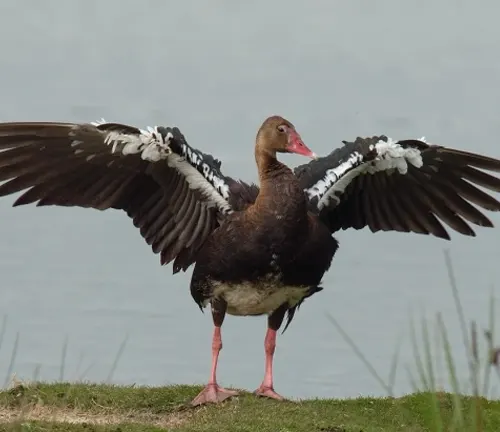
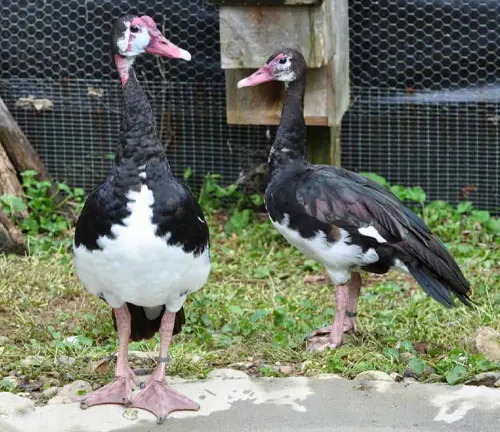
Pair Bonding
Spur-winged Geese form monogamous breeding pairs, with individuals often mating for life. During the breeding season, pairs engage in elaborate courtship displays to strengthen their bond and establish a nesting site.
Nest Construction
Once a suitable nesting site is chosen, typically near water but hidden from predators, the female Spur-winged Goose constructs the nest using grasses, reeds, and other plant materials. The nest is usually a shallow depression lined with soft vegetation to provide cushioning for the eggs.
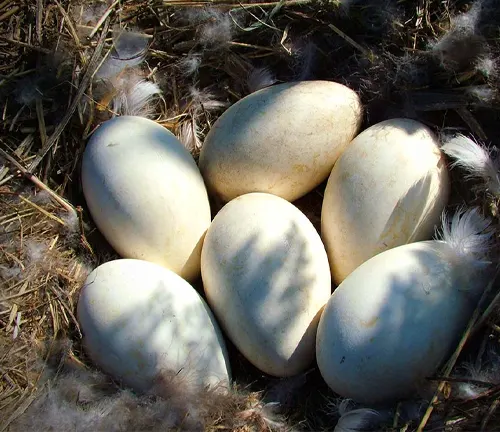
Egg Laying
After the nest is constructed, the female lays a clutch of eggs, typically ranging from 4 to 8 eggs, although clutch size can vary. The eggs are incubated primarily by the female, although the male may also take turns incubating the eggs to share parental responsibilities.
Incubation
The incubation period for Spur-winged Goose eggs lasts approximately 30 to 35 days, during which the parents take turns sitting on the eggs to keep them warm and protected. The eggs are carefully tended to regulate temperature and humidity levels, ensuring the optimal conditions for embryo development.
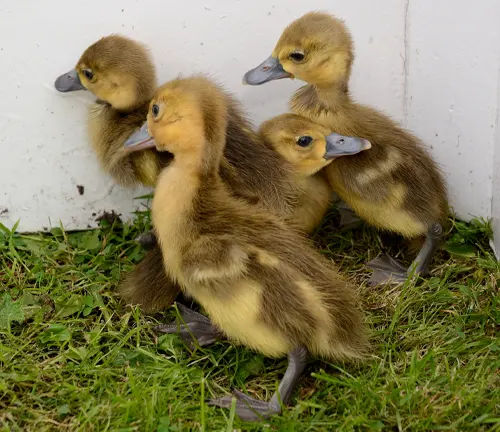
Hatching and Chick Rearing
Once the eggs hatch, the parents care for the young goslings, providing them with warmth, protection, and nourishment. The goslings are precocial, meaning they are born with their eyes open and are capable of walking, swimming, and foraging shortly after hatching. The parents guide the goslings to feeding areas and teach them essential survival skills, such as avoiding predators and finding food.
Parental Care
Both male and female Spur-winged Geese play active roles in raising their offspring, with the male assisting in feeding, guarding, and protecting the goslings from potential threats. The parents remain vigilant to ensure the safety and well-being of their young until they are old enough to fend for themselves.

Fledging
After several weeks, the goslings reach maturity and are ready to leave the nest, a stage known as fledging. At this point, they are capable of flying and are gradually weaned off parental care as they become more independent.
Conservation Status
The conservation status of Spur-winged Geese varies across their range, with populations facing both localized threats and broader conservation challenges. Here’s an overview of their conservation status:
- IUCN Red List: The Spur-winged Goose (Plectropterus gambensis) is classified as “Least Concern” on the International Union for Conservation of Nature (IUCN) Red List of Threatened Species. This designation indicates that the species is not currently considered at high risk of extinction globally.
- Population Trends: While Spur-winged Geese may have stable or increasing populations in some regions, they face localized threats and population declines in others. Factors such as habitat loss, degradation of wetland habitats, pollution, and hunting pressure can impact local populations and contribute to population declines.
- Habitat Loss and Degradation: The conversion of wetlands for agriculture, urbanization, and infrastructure development poses a significant threat to Spur-winged Geese and their habitat. Loss of wetland habitat reduces available feeding and nesting sites, leading to declines in population numbers and distribution.
- Pollution: Pollution of wetlands from agricultural runoff, industrial discharge, and other sources can degrade water quality and impact the health of Spur-winged Geese and other aquatic species. Contaminants such as pesticides, heavy metals, and plastics can accumulate in the food chain, posing risks to wildlife health and reproduction.
- Hunting and Harvesting: Spur-winged Geese are hunted for food and traditional purposes in some areas of their range. Unsustainable hunting practices and illegal harvesting can have detrimental effects on local populations, especially if populations are already vulnerable due to other threats.
- Conservation Efforts: Several conservation initiatives aim to protect Spur-winged Geese and their wetland habitats. These efforts include the establishment of protected areas, wetland conservation projects, habitat restoration initiatives, and community-based conservation programs aimed at raising awareness and promoting sustainable resource management.
- International Agreements: Spur-winged Geese are protected under various international agreements and conventions, including the Convention on Wetlands of International Importance (Ramsar Convention) and the Convention on Migratory Species (CMS). These agreements aim to conserve wetland ecosystems and migratory bird species by promoting habitat conservation and sustainable use practices.
Interesting Facts
- Spur-winged Geese are among the largest waterfowl species in Africa.
- They are excellent swimmers and are often seen foraging in shallow water.
- Despite their size, Spur-winged Geese are agile flyers, capable of covering long distances during migration.
Different Species
The Spur-winged Goose, scientifically known as Plectropterus gambensis, is a singular species within the genus Plectropterus. There are no recognized subspecies or distinct species within the Spur-winged Goose genus.
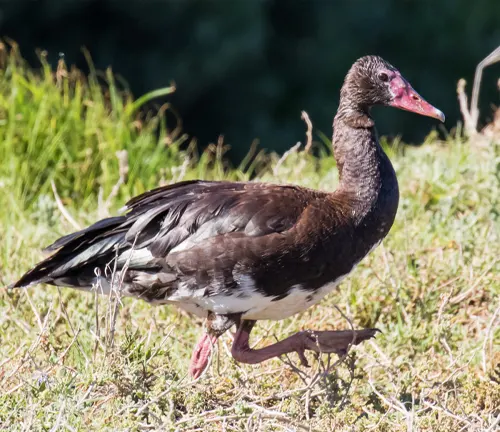
Frequently Asked Questions (FAQs)
- Are Spur-winged Geese aggressive birds?
Spur-winged Geese are generally not considered aggressive birds. They tend to be more cautious and defensive, particularly during the breeding season when they may become territorial to protect their nesting sites. - What is the lifespan of Spur-winged Geese in the wild?
In the wild, Spur-winged Geese typically have a lifespan of around 10 to 15 years, although some individuals may live longer under favorable conditions. - Do Spur-winged Geese migrate long distances?
Yes, Spur-winged Geese are known to undertake seasonal migrations, particularly in response to changes in food availability and breeding conditions. They may travel long distances to find suitable feeding and nesting grounds. - How do Spur-winged Geese communicate with each other?
Spur-winged Geese communicate through a variety of vocalizations, including honking calls, squawks, and hisses. They also use body language, such as head bobbing and wing displays, to convey information and establish social hierarchies. - Are Spur-winged Geese kept in captivity for conservation or ornamental purposes?
Yes, Spur-winged Geese are sometimes kept in captivity for conservation breeding programs, as well as for ornamental purposes in zoos, aviaries, and private collections. - Do Spur-winged Geese have any natural predators?
Spur-winged Geese face predation from various mammalian predators such as jackals, foxes, and large cats, as well as avian predators like eagles and large raptors. - What is the role of Spur-winged Geese in African folklore or cultural traditions?
In some African cultures, Spur-winged Geese hold symbolic significance and are featured in folklore, stories, and traditional rituals. They may represent qualities such as freedom, resilience, or connection to the natural world. - Can Spur-winged Geese adapt to different types of wetland habitats?
Yes, Spur-winged Geese are adaptable birds that can inhabit various wetland habitats, including marshes, swamps, lakes, and rivers, as long as suitable food and nesting sites are available. - How do Spur-winged Geese contribute to the dispersal of seeds in their environment?
Spur-winged Geese play a role in seed dispersal by consuming fruits and seeds from various wetland plants and then excreting the seeds in different locations, helping to propagate plant species in their habitat. - Are there any known diseases that affect Spur-winged Geese populations?
Spur-winged Geese may be susceptible to diseases commonly found in waterfowl, such as avian influenza, avian botulism, and avian cholera, which can impact their populations, particularly in areas with poor water quality or habitat degradation. - Do Spur-winged Geese have any specialized adaptations for their aquatic lifestyle?
Yes, Spur-winged Geese have adaptations for their aquatic lifestyle, including webbed feet for efficient swimming, waterproof plumage to stay dry while diving, and a specialized digestive system to process their herbivorous diet. - Are Spur-winged Geese legally protected in their native range?
The legal protection status of Spur-winged Geese varies across their range, with some countries implementing conservation measures and hunting regulations to manage their populations sustainably. - How do Spur-winged Geese defend themselves against predators?
Spur-winged Geese employ various defense mechanisms against predators, including alarm calls to alert others, flocking together for safety, and using their wings and beaks to fend off attackers. - What is the population trend of Spur-winged Geese in different regions of Africa?
Population trends of Spur-winged Geese vary regionally, influenced by factors such as habitat loss, hunting pressure, and environmental changes. In some areas, populations may be stable or increasing, while in others, they may be declining. - Do Spur-winged Geese exhibit any interesting behaviors during courtship or mating rituals?
During courtship displays, male Spur-winged Geese may engage in elaborate behaviors such as head bobbing, wing flapping, and vocalizations to attract females. Pairs often engage in synchronized swimming and other bonding activities before mating.


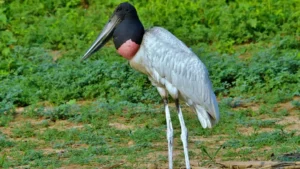

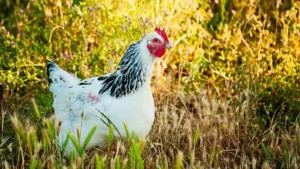


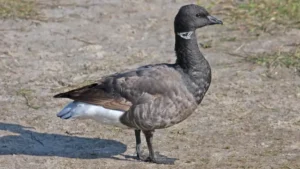
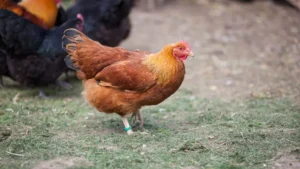
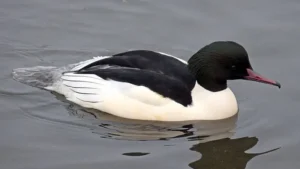
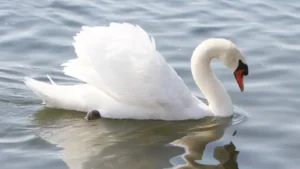
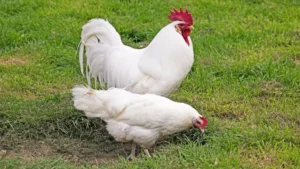
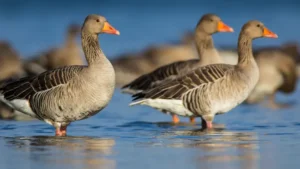
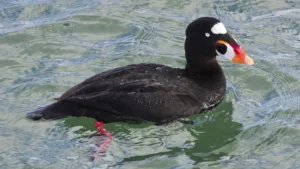
Leave your comment